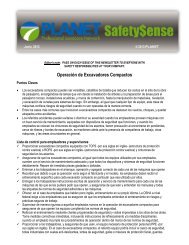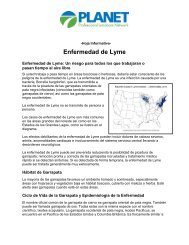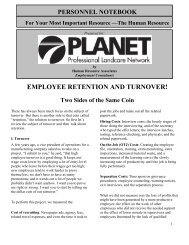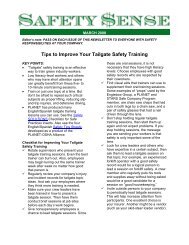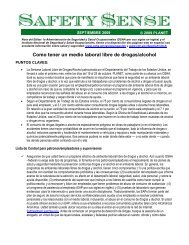Economic Impacts of the Green Industry in the - Urban Forest ...
Economic Impacts of the Green Industry in the - Urban Forest ...
Economic Impacts of the Green Industry in the - Urban Forest ...
You also want an ePaper? Increase the reach of your titles
YUMPU automatically turns print PDFs into web optimized ePapers that Google loves.
Retail Lawn and Garden Supply Stores<br />
<strong>Economic</strong> impacts <strong>of</strong> <strong>the</strong> retail lawn and garden supply stores are presented <strong>in</strong> Table 6-5. For <strong>the</strong> U.S. as a whole,<br />
this sector accounted for nearly $23 billion <strong>in</strong> output impacts, 347,916 jobs, contributed $14.8 billion <strong>in</strong> value<br />
added impacts, and paid $1.8 billion <strong>in</strong> <strong>in</strong>direct bus<strong>in</strong>ess taxes. These figures represent roughly 40 percent <strong>of</strong><br />
total economic impacts for <strong>the</strong> wholesale/retail trade group, mak<strong>in</strong>g it <strong>the</strong> largest <strong>of</strong> <strong>the</strong> seven horticultural<br />
<strong>in</strong>dustry sectors. At <strong>the</strong> state level, <strong>the</strong> top five states for this sector were California, Texas, Ill<strong>in</strong>ois, New York,<br />
and Pennsylvania. These five states contributed 31 percent <strong>of</strong> total output impacts, over one-fourth <strong>of</strong> all jobs, and<br />
nearly one-third <strong>of</strong> value added impacts and taxes. The next five states <strong>in</strong> terms <strong>of</strong> economic importance were<br />
Ohio, Michigan, Wiscons<strong>in</strong>, Florida, and M<strong>in</strong>nesota. These states contributed an additional 15 percent <strong>in</strong> each<br />
impact category, suggest<strong>in</strong>g <strong>the</strong> top 10 states produced just under half <strong>of</strong> national totals. The next top 10 states<br />
added an additional 25 percent to each impact category, <strong>in</strong>dicat<strong>in</strong>g that <strong>the</strong> top 20 states contributed roughly<br />
three-quarters <strong>of</strong> national economic impacts.<br />
Retail Build<strong>in</strong>g Materials and Supply Stores<br />
Table 6-6 presents state-level economic impact results for retail build<strong>in</strong>g materials and supply stores. This sector<br />
<strong>in</strong>cludes home improvement stores such as Lowe’s and Home Depot that, <strong>in</strong> addition to build<strong>in</strong>g supplies, have<br />
fairly sizable nursery and garden supply centers. Nationally, this sector generated just under $10 billion <strong>in</strong> output<br />
impacts and $6.5 billion <strong>in</strong> value added, supported 123,591 jobs, and paid $789 million <strong>in</strong> <strong>in</strong>direct bus<strong>in</strong>ess taxes.<br />
As a share <strong>of</strong> total economic activity from <strong>the</strong> seven sectors, this group contributed approximately 18 percent.<br />
The top five states were California, Texas, Florida, New York, and Ill<strong>in</strong>ois. These top tier states contributed over<br />
one third <strong>of</strong> total U.S. economic impacts and taxes for <strong>the</strong> build<strong>in</strong>g materials and supply sector. The second tier <strong>of</strong><br />
five states <strong>in</strong>cluded Pennsylvania, Georgia, Michigan, Ohio and New Jersey. These states contributed an<br />
additional 18 percent share <strong>of</strong> economic impacts, <strong>in</strong>dicat<strong>in</strong>g that <strong>the</strong> top 10 states comprised roughly half <strong>of</strong> <strong>the</strong><br />
total for each measure. The next 10 states represented ano<strong>the</strong>r 25 percent <strong>of</strong> <strong>the</strong> national total, mak<strong>in</strong>g <strong>the</strong> top 20<br />
states responsible for just over three-quarters <strong>of</strong> national output for <strong>the</strong> build<strong>in</strong>g materials and supply sector.<br />
Florists<br />
Information on <strong>the</strong> economic impacts <strong>of</strong> <strong>the</strong> U.S. florist <strong>in</strong>dustry is shown <strong>in</strong> Table 6-7. Nationally, this sector<br />
accounted for $7.2 billion <strong>in</strong> output impacts, supported 200,451 jobs, and paid over $400 million <strong>in</strong> <strong>in</strong>direct<br />
bus<strong>in</strong>ess taxes. As a share <strong>of</strong> total activity from <strong>the</strong> seven horticultural sectors, output impacts from florists<br />
represented 13 percent while <strong>the</strong> share <strong>of</strong> jobs was 22 percent, mak<strong>in</strong>g it <strong>the</strong> second largest sector. In terms <strong>of</strong><br />
state level impacts, <strong>the</strong> top five states were California, New York, Texas, Florida, and Ill<strong>in</strong>ois, account<strong>in</strong>g for just<br />
over one-third <strong>of</strong> total national impacts. The second tier <strong>of</strong> top five states was Pennsylvania, Ohio, Michigan,<br />
Massachusetts, and New Jersey. This group comprised around 20 percent <strong>of</strong> <strong>the</strong> total so that, when comb<strong>in</strong>ed with<br />
<strong>the</strong> first top five, <strong>the</strong> top 10 states accounted for over half <strong>of</strong> all output. The next 10 states represented 25 percent<br />
<strong>of</strong> national output for <strong>the</strong> florist <strong>in</strong>dustry, mak<strong>in</strong>g <strong>the</strong> top 20 compris<strong>in</strong>g between 75 and 80 percent <strong>of</strong> <strong>the</strong> total.<br />
Retail Food and Beverage Stores<br />
State level economic impacts <strong>of</strong> <strong>the</strong> U.S. retail food and beverage <strong>in</strong>dustry are presented <strong>in</strong> Table 6-8. For <strong>the</strong><br />
country as a whole, this group accounted for under 5 percent <strong>of</strong> economic impacts, mak<strong>in</strong>g it <strong>the</strong> smallest <strong>of</strong> <strong>the</strong><br />
seven sectors. This ra<strong>the</strong>r small share is due to <strong>the</strong> fact that most food retailers concentrate on cut flower<br />
arrangements ra<strong>the</strong>r than a full selection <strong>of</strong> ornamental plant products and services. In addition, although this is<br />
an <strong>in</strong>creas<strong>in</strong>g trend for grocery cha<strong>in</strong> stores to <strong>in</strong>corporate flower shops, many still do not provide this service.<br />
Nationally, this sector contributed nearly $2.3 billion <strong>in</strong> output impacts, $1.4 billion <strong>in</strong> value added impacts,<br />
supported over 35,000 employee positions, and paid $156 million <strong>in</strong> <strong>in</strong>direct bus<strong>in</strong>ess taxes. The top five<br />
produc<strong>in</strong>g states were California, Texas, Florida, New York, and Pennsylvania, which toge<strong>the</strong>r accounted for<br />
approximately 40 percent <strong>of</strong> total U.S. impacts. The second most important five states were New Jersey, Ill<strong>in</strong>ois,<br />
53



